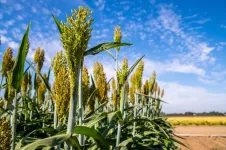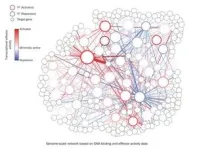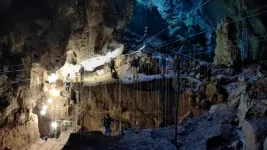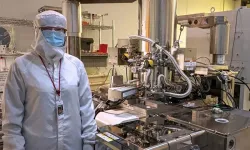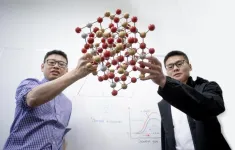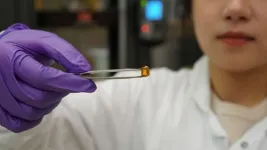A roadmap for gene regulation in plants
A novel approach to synthetic biology could revolutionize how scientists improve plants for bioenergy and agriculture
2023-06-21
(Press-News.org)
– By Will Ferguson
For the first time, researchers at the Department of Energy’s Lawrence Berkeley National Laboratory (Berkeley Lab) have developed a genome-scale way to map the regulatory role of transcription factors, proteins that play a key role in gene expression and determining a plant’s physiological traits. Their work reveals unprecedented insights into gene regulatory networks and identifies a new library of DNA parts that can be used to optimize genetic engineering efforts in plants.
“Transcription factors regulate things like how plants grow, how much fruit they produce, and what their root architecture looks like,” said Niklas Hummel, lead author of a study on the research in the journal Cell Systems and a research associate at the Department of Energy’s Joint BioEnergy Institute (JBEI), which is managed by Berkeley Lab. “By deciphering their regulatory role, we can identify new strategies to engineer more drought-resilient bioenergy crops and other plants with improved agronomic traits.”
Hummel and study senior author Patrick Shih, a faculty scientist in Berkeley Lab’s Biosciences Area and Director of Plant Biosystems Design at JBEI, set out to develop a method to characterize a large number of transcription factors in a plant simultaneously. While methods to do this exist for other model organisms, such as animals, insects, and fungi, applying them to plants has been challenging, due to their complexity and the disrupting presence of cell walls.
“To date, these kinds of studies have really been done piecemeal in plants, where we only understood the function of a particular transcription factor because one group of researchers has focused on it for many years,” Shih said, who is also an investigator at the Innovative Genomics Institute. “So, what we tried to do instead was come up with a way to map the activity of hundreds of these transcription factors in a plant at the same time.”
To address this challenge, Hummel and Shih employed a transient expression system they had previously developed for building synthetic biology tools in plants. Here, they used the system to characterize, in parallel, a network of over 400 transcriptional effector domains in the tobacco plant Nicotiana benthamiana, a feat never before achieved in plant synthetic biology.
They then went on an extensive literature review to try to match the function of the transcription factors they had identified en masse with previous work done identifying the function of individual transcription factors in their network.
“We were able to show this is what people have seen when they individually studied the role transcription factors play in gene expression, and this is what we have seen when we have studied them in parallel,” Shih said. “It actually ended up aligning really well. This makes us confident that we can integrate our dataset into gene regulatory networks to identify key transcription factors for engineering important plant traits.”
One surprising aspect of the study was the discovery of similar mechanisms of transcriptional regulation across distantly related eukaryotes. By examining the function of transcription factor regulation in both plants and yeast, the researchers found shared functionality, highlighting the presence of deeply conserved mechanisms of gene regulation.
“We were surprised to see that many transcription-factor regulatory domains functioned the same across plants and yeast,” Hummel said. “We then expanded upon this to demonstrate how machine learning algorithms trained on yeast datasets could work to identify regulatory domains in plants.”
The findings of the study have important implications for agriculture and sustainability. Transcription factors play a crucial role in determining important traits in plants, so understanding how they work will help scientists develop strategies to improve agricultural practices and address environmental challenges.
Looking ahead, the researchers aim to expand their approach to study all transcription factors in Arabidopsis, a widely studied model plant species. This will further accelerate understanding of plant-specific gene regulation and facilitate advancements in the field of plant biology.
“Our ability to engineer and modify plants is dependent on our basic understanding of how various traits are regulated,” Shih said. “By understanding how key transcription factors may be master regulators of traits of interest, we could identify new strategies to improve bioenergy relevant traits.”
This work was supported by the Department of Energy’s Office of Science. JBEI is a DOE Bioenergy Research Center.
###
Founded in 1931 on the belief that the biggest scientific challenges are best addressed by teams, Lawrence Berkeley National Laboratory and its scientists have been recognized with 16 Nobel Prizes. Today, Berkeley Lab researchers develop sustainable energy and environmental solutions, create useful new materials, advance the frontiers of computing, and probe the mysteries of life, matter, and the universe. Scientists from around the world rely on the Lab’s facilities for their own discovery science. Berkeley Lab is a multiprogram national laboratory, managed by the University of California for the U.S. Department of Energy’s Office of Science.
DOE’s Office of Science is the single largest supporter of basic research in the physical sciences in the United States and is working to address some of the most pressing challenges of our time. For more information, please visit energy.gov/science.
END
ELSE PRESS RELEASES FROM THIS DATE:
2023-06-21
CHAMPAIGN, Ill. — Fifteen years of archaeological work in the Tam Pa Ling cave in northeastern Laos has yielded a reliable chronology of early human occupation of the site, scientists report in the journal Nature Communications. The team’s excavations through the layers of sediments and bones that gradually washed into the cave and were left untouched for tens of thousands of years reveals that humans lived in the area for at least 70,000 years – and likely even longer.
“When we first started excavating the cave, we never expected to find humans in that region,” said University of Illinois Urbana-Champaign anthropology professor Laura Shackelford, who led ...
2023-06-21
A new tool for generating microwave signals could help propel advances in wireless communication, imaging, atomic clocks, and more.
Frequency combs are photonic devices that produce many equally spaced laser lines, each locked to a specific frequency to produce a comb-like structure. They can be used to generate high-frequency, stable microwave signals and scientists have been attempting to miniaturize the approach so they can be used on microchips.
Scientists have been limited in their abilities to tune these microcombs at a rate to make them effective. But a team of researchers ...
2023-06-21
By Lindsay Brownell
(BOSTON) — The amount of data generated by scientists today is massive, thanks to the falling costs of sequencing technology and the increasing amount of available computing power. But parsing through all that data to uncover useful information is like searching for a molecular needle in a haystack. Machine learning (ML) and other artificial intelligence (AI) tools can dramatically speed up the process of data analysis, but most ML tools are difficult for non-ML experts to access and use. Recently, automated machine learning (AutoML) methods have been developed that can automate the design and deployment ...
2023-06-21
An international team of researchers, led by University of Toronto Engineering Professor Yu Zou, is using electric fields to control the motion of material defects. This work has important implications for improving the properties and manufacturing processes of typically brittle ionic and covalent crystals, including semiconductors — a crystalline material that is a central component of electronic chips used for computers and other modern devices.
In a new study published in Nature Materials, researchers from ...
2023-06-21
About The Study: This study of 23 undocumented immigrants with kidney failure receiving emergency dialysis found that a peer support group intervention achieved feasibility and acceptability. The findings suggest that a peer support group may be a patient-centered strategy to build camaraderie and provide emotional support in kidney failure, especially for socially marginalized uninsured populations who report limited English proficiency.
Authors: Lilia Cervantes, M.D., of the University of Colorado, Anschutz Medical Campus, in Aurora, is the corresponding author.
To ...
2023-06-21
A gel that combines both stiffness and toughness is a step forward in the bid to create biodegradable implants for joint injuries, according to new UBC research.
Mimicking articular cartilage, found in our knee and hip joints, is challenging. This cartilage is key to smooth joint movement, and damage to it can cause pain, reduce function, and lead to arthritis. One potential solution is to implant artificial scaffolds made of proteins that help the cartilage regenerate itself as the scaffold biodegrades. How well the cartilage regenerates is linked to how well a scaffold can mimic the biological properties of cartilage, and to date, researchers have struggled ...
2023-06-21
Vanderbilt researchers are part of a team that has developed a cutting-edge method that seeks to make the removal of salt from hypersaline industrial wastewater far more energy-efficient and cost-effective.
While desalination through reverse osmosis has made tremendous strides—allowing for salt removal from seawater for less than a penny per gallon—it still falls short in eliminating saline in wastewater from industries like mining, oil and gas and power generation and in inland brackish water. The industrial brines are currently injected into deep geological formations or transferred to a evaporation ponds, and both disposal methods are facing more regulatory and ...
2023-06-21
In a new paper published today in Nature, researchers at the Francis Crick Institute have outlined the structure and function of a protein complex which is required to repair damaged DNA and protect against cancer.
Every time a cell replicates, mistakes can happen in the form of mutations, but specialised proteins exist to repair the damaged DNA.
People with mutations in a DNA repair protein called BRCA2 are predisposed to breast, ovarian and prostate cancers, which often develop at a young age. In the clinic, these cancers are treated with a drug that inhibits PARP, ...
2023-06-21
The discovery of the quantum Hall effects in the 1980's revealed the existence of novel states of matter called "Laughlin states", in honor of the American Nobel prize winner who successfully characterized them theoretically. These exotic states specifically emerge in 2D materials, at very low temperature and in the presence of an extremely strong magnetic field. In a Laughlin state, electrons form a peculiar liquid, where each electron dances around its congeners while avoiding them as much as possible. Exciting such a quantum liquid generates collective states that physicists associate to fictitious particles, whose ...
2023-06-21
New research is increasing our understanding about why some women with the most lethal form of ovarian cancer respond much better to treatment than others.
Researchers at Imperial College London have confirmed that the tumours of some women with high-grade serious ovarian cancer (HGSOC) contain a type of lymphoid tissue – known as tertiary lymphoid structures, or TLS – and that the presence of this tissue gives women a significantly better prognosis. They have also identified genes in HGSOC ...
LAST 30 PRESS RELEASES:
[Press-News.org] A roadmap for gene regulation in plants
A novel approach to synthetic biology could revolutionize how scientists improve plants for bioenergy and agriculture
